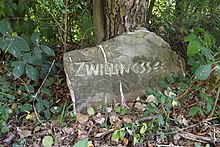Twin lake
| Twin lake | ||
|---|---|---|

|
||
| Zwillingssee near Brühl | ||
| Geographical location | Rhein-Erft-Kreis , North Rhine-Westphalia | |
| Tributaries | Groundwater | |
| Drain | Donatussee | |
| Location close to the shore | Brühl (Rhineland) , Erftstadt | |
| Data | ||
| Coordinates | 50 ° 48 '3.6 " N , 6 ° 51' 14.4" E | |
|
|
||
| Altitude above sea level | 120.9 m above sea level NHN | |
| surface | 1.5 ha | |
| length | 210 m | |
| width | 90 m | |
| volume | 24,000 m³ | |
| Maximum depth | 3.7 m | |
| Middle deep | 1.6 m | |
| PH value | 7.8 | |
|
particularities |
||
The Zwillingssee is located in the municipality of the city of Brühl (Rhineland) in North Rhine-Westphalia and is part of the Villeseen . Today it is designated as a nature reserve.
Location and description
The twin lake is a smaller lake of the Ville lakes with a water surface of 1.5 hectares. It is located approx. 2.5 km southeast of Liblar between the Donatussee in the north-west, the Villenhofer Maar in the north-east and the Silbersee in the south-west. It consists of three partial lakes and is connected to a small pond in the west by a canal, over which the drain runs to the Donatussee. The twin lake receives its inflow from groundwater.
The eastern part is very flat and mostly silted up, while the other two parts, with the exception of the front sides, have very steep bank sections.
As part of the Villeseen, the Zwillingssee also belongs to the Rhineland Nature Park .
Origin and history
Like almost all Villeseen, the Zwillingssee was created with the end of the lignite mining . It was created in 1955, making it one of the youngest lakes in the Lake District. The lakes have been designated as a landscape protection area since 1972 . Until the early 1990s, the western part of the lake was used for fishing, while the other two sections were already designated as a quiet zone. The established fishing spots were also used as storage and swimming spots.
After the fishing spots were dismantled and the fish population regulated, the lake was declared a nature reserve in 1990.
Web links
- Nature reserve "Zwillingssee" (BM-022) in the specialist information system of the State Office for Nature, Environment and Consumer Protection in North Rhine-Westphalia
See also
Individual evidence
- ↑ a b c d e f g h i Environmental research plan of the Federal Ministry for the Environment, Nature Conservation and Nuclear Safety. Lignite mining lakes in Germany. (PDF), accessed June 20, 2014.
- ↑ a b Rhineland Nature Park: Zwillingssee ( memento from June 20, 2014 in the web archive archive.today ), accessed on June 20, 2014.



